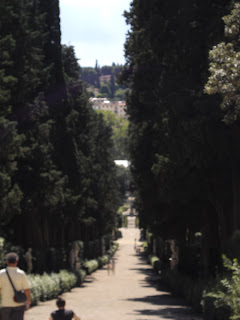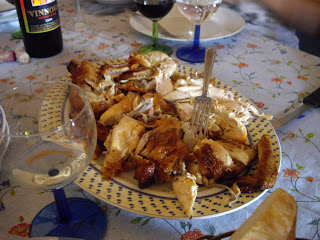10 STEPS TO RESTORING A FRESCO
Well, yesterday was certainly unexpected. I finally finished my fresco based upon Boticelli's Madonna del Mare and was excited to bring it home back to the States. But oh, wait. I painted the fresco on plaster-- meaning an actual wall! Thus it'd be impossibly heavy (and pretty pricey!) to bring back. Our professor, Lorenzo Casamenti, had prepared for this, though.
To take our frescoes home, we were to learn the first part in restoration, namely pulling the fresco painting from the plaster wall and transferring it onto canvas. Dicey, I know. We did what true art restorers did centuries before us and what our professor does regularly to transport valuable frescoes. The only catch, however, is that transferring a fresco from plaster to canvas chips away some of the paint, or in other words, destroys it. But that's when HaRdXcOrE restoration painting skillz come into play!
Here's the transfer, step-by-step (day-by-day...remember that show???):
Step 1. Adhere canvas to fresco (on plaster) with animal glue. This glue is very special and usually made from elephant or giraffe cartilage. No joke. This will cause the painting to peel off from the plaster and stick to the canvas. A reverse image is made.
Step 2. After allowing a full day for the paint to be pulled up from the plaster, you sand away the back portion with all the extra plaster that may have joined the ride and attach another piece of canvas behind the painting using synthetic glue. This creates a "fresco sandwich," (canvas-fresco-canvas).
Step 3. Again, allow a full day for the synthetic glue to dry. To remove the first piece of canvas attached with animal glue, soak the entire "fresco sandwich" in a hot water bath.
Step 4. To detach, rub the painting gently and allow the glue to dissolve while you pull away the front canvas. The painting should adhere to the canvas with synthetic glue (it's no longer the reverse image).
Step 5. Pat dry. Pat dry again.
Step 6. Repeat step 5.
Step 7. If patting's not enough--use a blow-dryer on crack! Aka 100x hotter than a normal hair dryer!
Step 8. Paint the missing bits in with dilute tempera paint. Apply onto the parts where obvious damage has occurred. Continue adding dilute tempera tint, really, until it's in the same color family as the original. It's important, apparently, that the paint not perfectly match the original to show where the restoration has occurred without detracting from the piece's entirety.
"We don't want an imitation! We make similar, not the same!"
--Prof
Step 9. Step back and squint-- It's alive!
Step 10. Pick spinach from teeth.

















































